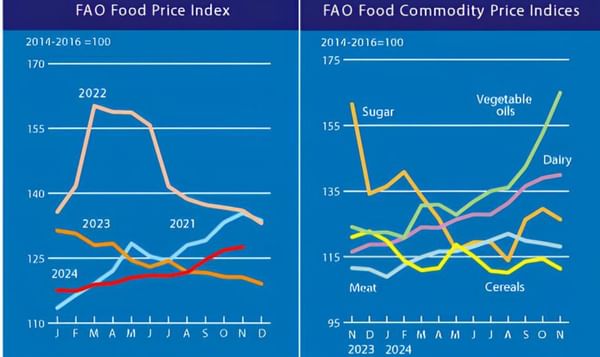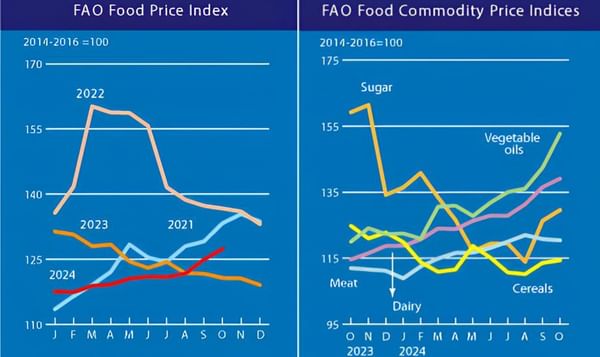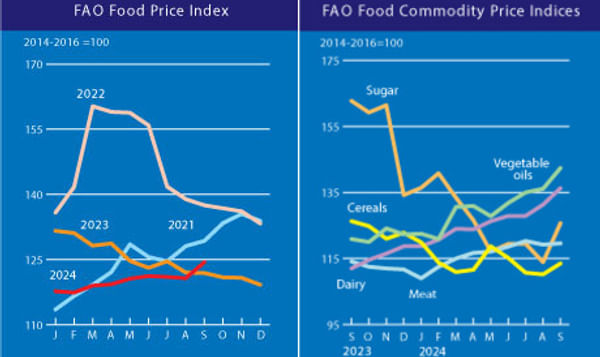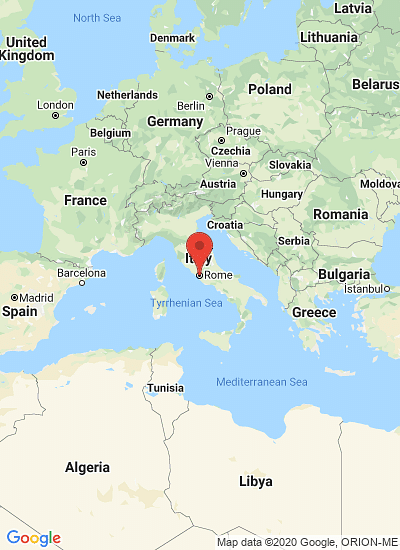The FAO Food Price Index (FFPI) in January 2017 averaged 173.8 points, up 3.7 points (2.1 percent) from the revised December value. At this level, the FFPI is at its highest value since February 2015.
January 2017 FAO Food Price Index at its highest value since February 2015
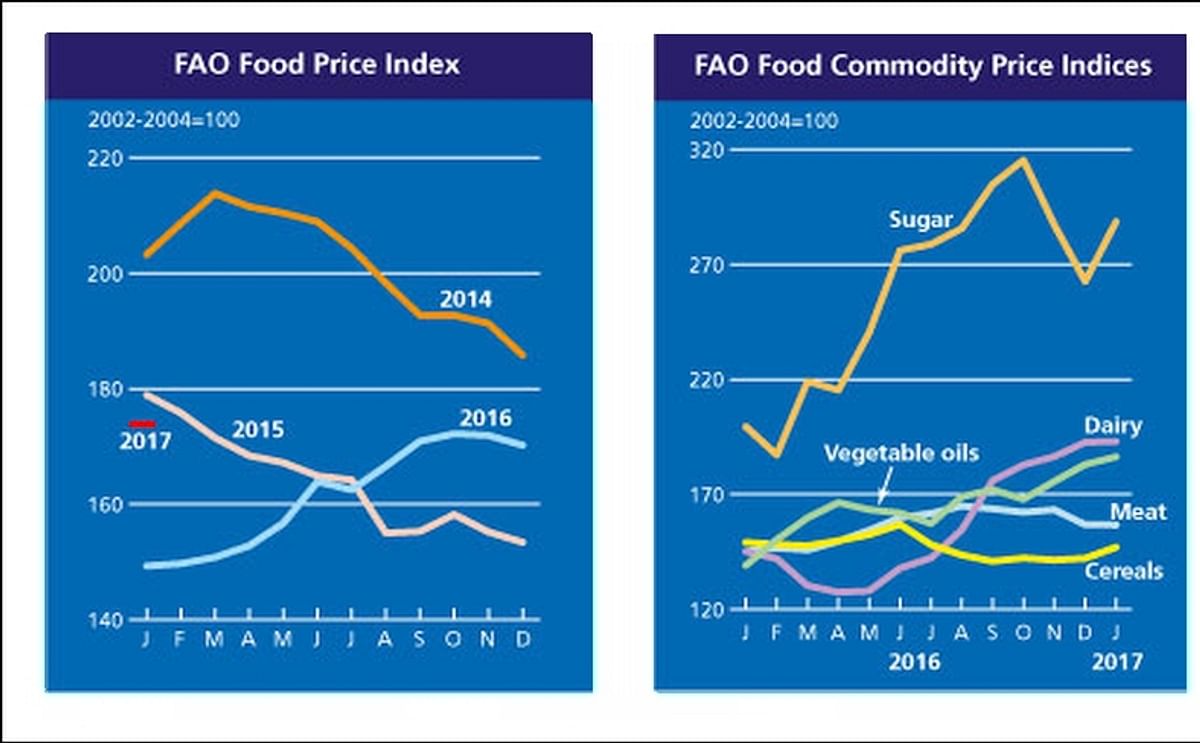
The FAO Food Price Index (FFPI) in January 2017 averaged 173.8 points, up 3.7 points (2.1 percent) from the revised December value. At this level, the FFPI is at its highest value since February 2015 and as much as 24.5 points (16.4 percent) above its level in the corresponding period last year. The strong rebound in the January value of the FFPI was driven by a surge in international sugar quotations and sharp increases in export prices of cereals as well as vegetable oils. Meat and dairy markets remained more stable.
The FAO Cereal Price Index averaged 147 points in January, 4.8 points (3.4 percent) above December and representing a six-month high. International prices of all major cereals strengthened in January. Wheat values rose mostly on concerns over unfavourable weather hampering 2017 crops and the reported reduction in winter wheat area in the United States. The firming of maize values largely reflected strong demand and uncertain crop prospects in South America. International rice prices also increased, amid expectations of a return of important buyers to the market, coupled with lower export availabilities in India as a result of ongoing state procurement.
The FAO Vegetable Oil Price Index averaged 186.3 points in January, up 3.3 points (1.8 percent) from December and marking the third consecutive monthly increase. The rise continued to be driven by palm oil, the prices of which climbed to a 30-month high on persistent concerns over slow production recovery in Southeast Asia and low global inventory levels, amid strong import demand. While rapeseed oil prices also increased further, fuelled by a tight supply outlook for 2016/17, soy oil prices eased on expectations of ample global availabilities, notwithstanding recent downward revisions for soy crops in the US and Argentina.
The FAO Dairy Price Index averaged 193 points in January, unchanged from December. Prices were little changed across the board, a marked departure from the trend recorded in the second half of 2016, when the Index jumped by 50 percent (May-December). With peak seasonal production moving from the southern to the northern hemisphere and many major buyers having secured adequate supplies in earlier months, trade remained subdued.
The FAO Meat Price Index averaged 156.7 points in January, almost unchanged from its revised value for December. A rise in quotations for bovine meat was counterbalanced by a fall for those of ovine meat and a small decrease for poultry and pig meat. In Australia, herd rebuilding constrained supplies of bovine meat for export and caused prices to climb. In the case of ovine meat, Oceania export prices dropped for the third month in a row, reflecting the seasonal slaughter peak and an associated boost in supply. Pig and poultry meat quotations also recorded their third month of decline, with a market characterized by generally abundant world supplies and stable demand.
The FAO Sugar Price Index averaged 288.5 points in January, up 26 points (9.9 percent) from December 2016. The sharp increase in international sugar prices in January was mainly underpinned by firmer expectations of a global sugar production shortfall in 2016/17. Less buoyant growth prospects for sugar output are mainly attributed to protracted supply tightness in some of the key sugar producing regions, specifically in Brazil, the world’s largest sugar producer and exporter, as well as in India, the world’s second largest producer, and Thailand.
The FAO Cereal Price Index averaged 147 points in January, 4.8 points (3.4 percent) above December and representing a six-month high. International prices of all major cereals strengthened in January. Wheat values rose mostly on concerns over unfavourable weather hampering 2017 crops and the reported reduction in winter wheat area in the United States. The firming of maize values largely reflected strong demand and uncertain crop prospects in South America. International rice prices also increased, amid expectations of a return of important buyers to the market, coupled with lower export availabilities in India as a result of ongoing state procurement.
The FAO Vegetable Oil Price Index averaged 186.3 points in January, up 3.3 points (1.8 percent) from December and marking the third consecutive monthly increase. The rise continued to be driven by palm oil, the prices of which climbed to a 30-month high on persistent concerns over slow production recovery in Southeast Asia and low global inventory levels, amid strong import demand. While rapeseed oil prices also increased further, fuelled by a tight supply outlook for 2016/17, soy oil prices eased on expectations of ample global availabilities, notwithstanding recent downward revisions for soy crops in the US and Argentina.
The FAO Dairy Price Index averaged 193 points in January, unchanged from December. Prices were little changed across the board, a marked departure from the trend recorded in the second half of 2016, when the Index jumped by 50 percent (May-December). With peak seasonal production moving from the southern to the northern hemisphere and many major buyers having secured adequate supplies in earlier months, trade remained subdued.
The FAO Meat Price Index averaged 156.7 points in January, almost unchanged from its revised value for December. A rise in quotations for bovine meat was counterbalanced by a fall for those of ovine meat and a small decrease for poultry and pig meat. In Australia, herd rebuilding constrained supplies of bovine meat for export and caused prices to climb. In the case of ovine meat, Oceania export prices dropped for the third month in a row, reflecting the seasonal slaughter peak and an associated boost in supply. Pig and poultry meat quotations also recorded their third month of decline, with a market characterized by generally abundant world supplies and stable demand.
The FAO Sugar Price Index averaged 288.5 points in January, up 26 points (9.9 percent) from December 2016. The sharp increase in international sugar prices in January was mainly underpinned by firmer expectations of a global sugar production shortfall in 2016/17. Less buoyant growth prospects for sugar output are mainly attributed to protracted supply tightness in some of the key sugar producing regions, specifically in Brazil, the world’s largest sugar producer and exporter, as well as in India, the world’s second largest producer, and Thailand.
Like to receive news like this by email? Join and Subscribe!
Join Our Telegram Channel for regular updates!
精选企业
Sponsored Content
Sponsored Content
Sponsored Content
Sponsored Content
Sponsored Content



